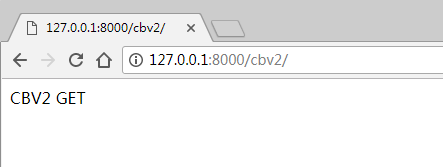Django CBV模式的源码解析
通常来说,http请求的本质就是基于Socket
Django的视图函数,可以基于FBV模式,也可以基于CBV模式。
基于FBV的模式就是在Django的路由映射表里进行url和视图函数的关联,而基于CBV的模式则是在views.py文件中定义视图类,在视图类中视图函数,如get,post,put,delete等
使用Django新建一个项目,新建一个路由映射
from django.conf.urls import urlfrom django.contrib import adminfrom app01 import viewsurlpatterns = [ url(r'^cbv/$',views.CBV.as_view())]
对应的views.py文件内容:
from django.shortcuts import render,HttpResponsefrom django.views import Viewclass CBV(View): def get(self,request): return HttpResponse("GET") def post(self,request): return HttpResponse("POST") 启动项目,使用浏览器请求URLhttp://127.0.0.1:8000/cbv/,浏览器显示结果为:

请求到达Django会先执行Django中间件里的方法,然后进行进行路由匹配。
在路由匹配完成后,会执行CBV类中的as_view方法。
CBV中并没有定义as_view方法,由于CBV继承自Django的View,所以会执行Django的View类中的as_view方法
Django的View类的as_view方法的部分源码
class View(object): """ Intentionally simple parent class for all views. Only implements dispatch-by-method and simple sanity checking. """ http_method_names = ['get', 'post', 'put', 'patch', 'delete', 'head', 'options', 'trace'] def __init__(self, **kwargs): """ Constructor. Called in the URLconf; can contain helpful extra keyword arguments, and other things. """ # Go through keyword arguments, and either save their values to our # instance, or raise an error. for key, value in six.iteritems(kwargs): setattr(self, key, value) @classonlymethod def as_view(cls, **initkwargs): """ Main entry point for a request-response process. """ for key in initkwargs: if key in cls.http_method_names: raise TypeError("You tried to pass in the %s method name as a " "keyword argument to %s(). Don't do that." % (key, cls.__name__)) if not hasattr(cls, key): raise TypeError("%s() received an invalid keyword %r. as_view " "only accepts arguments that are already " "attributes of the class." % (cls.__name__, key)) def view(request, *args, **kwargs): self = cls(**initkwargs) if hasattr(self, 'get') and not hasattr(self, 'head'): self.head = self.get self.request = request self.args = args self.kwargs = kwargs return self.dispatch(request, *args, **kwargs) view.view_class = cls view.view_initkwargs = initkwargs # take name and docstring from class update_wrapper(view, cls, updated=()) # and possible attributes set by decorators # like csrf_exempt from dispatch update_wrapper(view, cls.dispatch, assigned=()) return view 从View的源码可以看出,在View类中,先定义了http请求的八种方法
http_method_names = ['get', 'post', 'put', 'patch', 'delete', 'head', 'options', 'trace']
在as_view方法中进行判断,如果请求的方法没在http_method_names中,则会抛出异常,这里的cls实际上指的是自定义的CBV类
接着as_view方法中又定义view方法,在view方法中对CBV类进行实例化,得到self对象,然后在self对象中封装浏览器发送的request请求
self = cls(**initkwargs)
最后又调用了self对象中的dispatch方法并返回dispatch方法的值来对request进行处理
此时,由于self对象就是CBV实例化得到,所以会先执行自定义的CBV类中的dispatch方法。如果CBV类中没有定义dispatch方法则执行Django的View中的dispatch方法
Django的View中的dispatch方法源码
class View(object): """ 中间省略 """ def dispatch(self, request, *args, **kwargs): # Try to dispatch to the right method; if a method doesn't exist, # defer to the error handler. Also defer to the error handler if the # request method isn't on the approved list. if request.method.lower() in self.http_method_names: handler = getattr(self, request.method.lower(), self.http_method_not_allowed) else: handler = self.http_method_not_allowed return handler(request, *args, **kwargs)
在dispatch方法中,把request.method转换为小写再判断是否在定义的http_method_names中,如果request.method存在于http_method_names中,则使用getattr反射的方式来得到handler
在这里的dispatch方法中,self指的是自定义的CBV类实例化得到的对象
从CBV类中获取request.method对应的方法,再执行CBV中的方法并返回
由此,可以知道如果在Django项目中使用CBV的模式,实际上调用了getattr的方式来执行获取类中的请求方法对应的函数
结论:
CBV基于反射实现根据请求方式不同,执行不同的方法
自定义dispatch方法
如果想在基于CBV模式的项目中在请求某个url时执行一些操作,则可以在url对应的类中定义dispatch方法
修改views.py文件
class CBV(View): def dispatch(self, request, *args, **kwargs): func = getattr(self,request.method.lower()) return func(request,*args,**kwargs) def get(self,request): return HttpResponse("GET") def post(self,request): return HttpResponse("POST") 也可以使用继承的方式重写dispatch方法:
class CBV(View): def dispatch(self, request, *args, **kwargs): print("before") res = super(CBV, self).dispatch(request, *args, **kwargs) print("after") return res def get(self,request): return HttpResponse("GET") def post(self,request): return HttpResponse("POST") 刷新浏览器,Django后台打印结果如下:

浏览器页面结果

同理,如果有基于CBV的多个类,并且有多个类共用的功能,为了避免重复,可以单独定义一个类,在这个类中重写dispatch方法,然后让url对应的视图类继承这个类
修改urls.py文件
from django.conf.urls import urlfrom django.contrib import adminfrom app01 import viewsurlpatterns = [ url(r'^cbv1/$',views.CBV1.as_view()), url(r'^cbv2/$',views.CBV2.as_view()),]
views.py文件内容
from django.shortcuts import render,HttpResponsefrom django.views import Viewclass BaseView(object): def dispatch(self, request, *args, **kwargs): func = getattr(self, request.method.lower()) return func(request, *args, **kwargs)class CBV1(BaseView,View): def get(self,request): return HttpResponse("CBV1 GET") def post(self,request): return HttpResponse("CBV1 POST")class CBV2(BaseView,View): def get(self,request): return HttpResponse("CBV2 GET") def post(self,request): return HttpResponse("CBV2 POST") 通过python的面向对象可以知道,请求到达视图类时,会先执行CBV1和CBV2类中的dispatch方法,然而CBV1和CBV2类中并没有dispatch方法,则会按照顺序在父类中查找dispatch方法,此时就会执行BaseView类中的dispatch方法了
用浏览器请求urlhttp://127.0.0.1:8000/cbv1/,浏览器页面显示

用浏览器请求urlhttp://127.0.0.1:8000/cbv2/,浏览器页面显示
